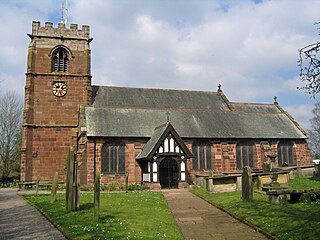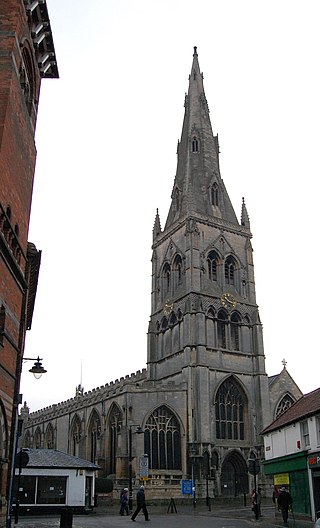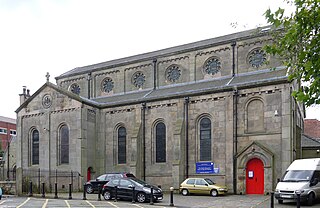
Wittering is a village and civil parish in the City of Peterborough unitary authority area in the ceremonial county of Cambridgeshire, England. The village is about 3 miles (5 km) south of the market town of Stamford in neighbouring Lincolnshire and about 9 miles (14 km) west of Peterborough's urban sprawl.

All Saints Church stands to the north of the village of Handley, Cheshire, England. It is recorded in the National Heritage List for England as a designated Grade II* listed building. The church is an active Anglican parish church in the diocese of Chester, the archdeaconry of Chester and the deanery of Malpas. Its benefice is combined with that of St Alban, Tattenhall.

St Alban's Church is in the village of Tattenhall, Cheshire, England. It is an active Anglican parish church in the diocese of Chester, the archdeaconry of Chester and the deanery of Malpas. Its benefice is combined with that of All Saints, Handley. The church is recorded in the National Heritage List for England as a designated Grade II* listed building.

St Mary's Church is located on Overleigh Road in Handbridge, an area south of the River Dee, in the city of Chester, Cheshire, England. It is also known as the Church of St Mary-without-the-Walls, which was to distinguish it from Church of St Mary-on-the-Hill across the River Dee within the city walls. The church is recorded in the National Heritage List for England as a designated Grade II* listed building. It is an active Anglican parish church in the diocese of Chester, the archdeaconry of Chester and the deanery of Chester.

St Michael's Church is in St Michael's Road, Ditton, Widnes, Halton, Cheshire, England. It is recorded in the National Heritage List for England as a designated Grade II* listed building. It is an active Roman Catholic church.

St Mary Magdalene Church, Newark-on-Trent is the parish church of Newark-on-Trent in Nottinghamshire, England. It is dedicated to Mary Magdalene and is the tallest structure in the town.

St Michael and All Angels' Church, Elton on the Hill is a parish church in the Church of England in Elton on the Hill, Nottinghamshire. It is Grade II listed by the Department for Digital, Culture, Media and Sport as a building of special architectural interest.

St Andrew's Church is a redundant Anglican church at the south end of the village of East Heslerton, North Yorkshire, England. It is recorded in the National Heritage List for England as a designated Grade I listed building and is under the care of the Churches Conservation Trust.

St Gregory's Church is a redundant Anglican church in Fledborough, Nottinghamshire, England. It is recorded in the National Heritage List for England as a designated Grade I listed building, and is under the care of the Churches Conservation Trust. The church stands at the end of a lane, in meadows near the River Trent.

Holy Trinity Church is in the village of Casterton, Cumbria, England. It is an active Anglican parish church in the deanery of Kendal, the archdeaconry of Westmorland and Furness, and the diocese of Carlisle. Its benefice is united with those of five local parishes, the benefice being entitled Kirkby Lonsdale Team Ministry. The church is recorded in the National Heritage List for England as a designated Grade II listed building.

Preston Minster, formally the Minster Church of St John the Evangelist, is in Church Street, in the centre of Preston, Lancashire, England. From its origin it has been the parish church of Preston. It is an active Anglican church in the deanery of Preston, the archdeaconry of Lancaster and the diocese of Blackburn. Its benefice is united with that of St George, Preston. St John's is recorded in the National Heritage List for England as a designated Grade II* listed building.

St George's Church is in St George's Street, Chorley, Lancashire, England. It is an active Anglican parish church in the deanery of Chorley, the archdeaconry of Blackburn, and the diocese of Blackburn. The church is recorded in the National Heritage List for England as a designated Grade II* listed building. It was a Commissioners' church, having received a grant towards its construction from the Church Building Commission.
St Peter's Church is in Earle Street, Crewe, Cheshire, England. It is an active Anglican parish church in the deanery of Nantwich, the archdeaconry of Macclesfield, and the diocese of Chester. Its benefice is combined with that of All Saints and St Paul, Crewe. The church is recorded in the National Heritage List for England as a designated Grade II listed building.

All Saints' Church is in Main Road, Weston, Cheshire, England. It is an active Anglican parish church in the deanery of Nantwich, the archdeaconry of Macclesfield, and the diocese of Chester. Its benefice is combined with that of St Mark, Shavington. The church is recorded in the National Heritage List for England as a designated Grade II listed building.

The Church of St George the Martyr is in George's Road, off Lune St, Preston, Lancashire, England. It is an active Anglican parish church in the deanery of Preston, the archdeaconry of Lancaster, and the diocese of Blackburn. Its benefice is united with that of St John, Preston. The church is recorded in the National Heritage List for England as a designated Grade II* listed building.

St Edith's Church is in the village of Eaton-under-Heywood, Shropshire, England. It stands on the lower slopes of Wenlock Edge. The church, dedicated to Saint Edith of Wilton, is an active Anglican parish church in the deanery of Condover, the archdeaconry of Ludlow, and the diocese of Hereford. Its benefice is united with that of St Andrew, Hope Bowdler. The church is recorded in the National Heritage List for England as a designated Grade I listed building.

St John the Baptist's Church, Collingham is a Grade I listed parish church of the Church of England in the village of Collingham, Nottinghamshire.
Sidney Gambier-Parry was a British architect.

All Saints' Episcopal Church is a historic Episcopal parish church in Austin, Texas, United States. Built in 1899 on the edge of the University of Texas at Austin campus, the church has long-standing connections with the university's student body and faculty. The chapel was a project of Episcopal Bishop George Herbert Kinsolving, whose crypt is located under the church. It has been designated as a City of Austin Historic Landmark since 1980 and a Recorded Texas Historic Landmark since 2014, and it was listed on the National Register of Historic Places in 2015.

St Andrew's Church is the parish church of Langley Mill in Derbyshire, England. It was built in 1911 by J S Brocklesby and was dedicated to Saint Andrew in 1912 by the Bishop of Southwell. In 1926, the church became part of the Diocese of Derby. The church is an active place of worship and community hub. It was designated a Grade II listed building in 1988 by Historic England.




















